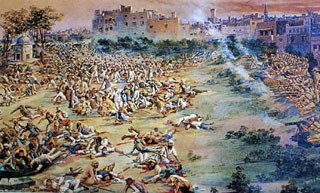Indian National Movement (1917 - 1947)
In 1917, a committee was set up under the presidentship of Sir Sydney Rowlatt to look into the militant Nationalist activities. On the basis of its report the Rowlatt Act was passed in March 1919 by the Central Legislative Council. As per this Act, any person could be arrested on the basis of suspicion. No appeal or petition could be filed against such arrests. This Act was called the Black Act and it was widely opposed.
An all-India hartal was organized on 6 April 1919. Meetings were held all over the country. Mahatma Gandhi was arrested near Delhi. Two prominent leaders of Punjab, Dr Satya Pal and Dr. Saifuddin Kitchlew, were arrested in Amritsar.
 |
| Jallianwala Bagh Massacre |
The Jallianwala Bagh Massacre took place on 13 April 1919 and it remained a turning point in the history of India’s freedom movement. In Punjab, there was an unprecedented support to the Rowlatt Satyagraha. Facing a violent situation, the Government of Punjab handed over the administration to the military authorities under General Dyer. He banned all public meetings and detained the political leaders. On 13 th April, the Baisakhi day (harvest festival), a public meeting was organized at the Jallianwala Bagh (garden). Dyer marched in and without any warning opened fire on the crowd. The firing continued for about 10 to 15 minutes and it stopped only after the ammunition exhausted. According to official report 379 people were killed and 1137 wounded in the incident. There was a nation- wide protest against this massacre and Rabindranath Tagore renounced his knighthood as a protest. The Jallianwala Bagh massacre gave a tremendous impetus to the freedom struggle.
Information related to the search:
Indian National Movement (1917 - 1947), india, history, bagh, massacre, jallianwala, april, movement, rowlatt, national, punjab, indian, arrested, protest, public, freedom, dyer, leaders, report, organized, meetings, over, basis